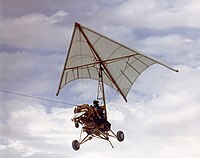
Photo from wikipedia
Inspired by the impressive shape reconfigurability in natural systems, stimulus-responsive soft materials have been exploited to enable reconfigurable surface changes, relying on controllable deformations inner soft materials and spatiotemporally varying… Click to show full abstract
Inspired by the impressive shape reconfigurability in natural systems, stimulus-responsive soft materials have been exploited to enable reconfigurable surface changes, relying on controllable deformations inner soft materials and spatiotemporally varying external stimuli. Among these, light stimulus, due to its high degree of spatial and temporal control manner, has been becoming a particularly powerful actuation means. Especially, photothermal shape transformations induced by bilayered structures, combining light absorption layer and an active layer of hydrogels, SMPs (Shape Memory Polymers), and nanocomposites, have provided a facile reconfigurable scheme. Here, we proposed reconfigurable shape-morphing flexible surfaces with individually addressable photoactuators arrays. By adjusting near-infrared radiation intensity and actuators thickness, the deformations of each actuator can be desirably tuned up to 350 μm. Additionally, actuator arrays can be individually photoactuated one by one due to the remote and straightforward control manner, which give rise to distinct surface morphology. Furthermore, multiple actuators are enabled to demonstrate coupled photomechanical actuation, causing broader area surface reconfigurations. Finally, we tried to explore shape-morphing flexible surfaces applications in a deformable mirror prototype with 19 actuator arrays. Based on photomechanical deformation simulation from COMSOL MultiPhysics, surface change capability was preliminarily researched. We envision that our proposed photoactuated deformable mirror will have a significant impact on the novel design in the future deformable mirrors and metasurfaces.
Journal Title: Smart Materials and Structures
Year Published: 2021
Link to full text (if available)
Share on Social Media: Sign Up to like & get
recommendations!